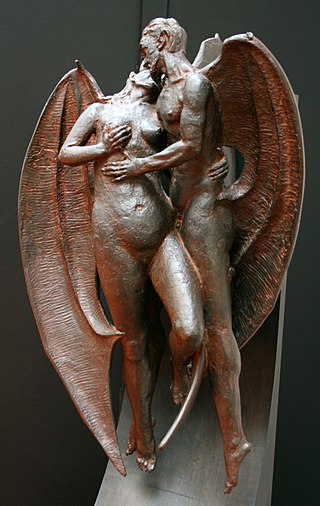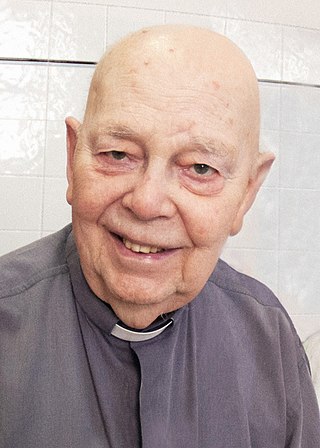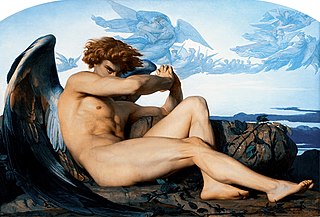This article relies largely or entirely on a single source .(December 2024) |
Xhindi is a mythological creature in Albanian mythology. [1]
This article relies largely or entirely on a single source .(December 2024) |
Xhindi is a mythological creature in Albanian mythology. [1]
Xhindis are usually depicted as invisible spirits, somewhat analogous to elves in Albanian folklore. Like the devil, Xhindi have entered Albanian demonology from the sphere of demonology of monotheistic religions, specifically from Islamic demonology. The Xhindi of Albanian popular superstition are found everywhere at night, outside in the garden or in the toilet. The places where they like to gather are the mouths of the rivers, where the raindrops are poured from the pool. Their arrival is signaled by the creaking of doors and flickering of lights. Their intentions may be benevolent or malevolent thus they are sometimes represented as kind and helpful while sometimes they appear as oppressive. [1]

A demon is a malevolent supernatural entity. Historically, belief in demons, or stories about demons, occurs in folklore, mythology, religion, and literature; these beliefs are reflected in media including comics, fiction, film, television, and video games. Belief in demons probably goes back to the Paleolithic age, stemming from humanity's fear of the unknown, the strange and the horrific. In ancient Near Eastern religions and in the Abrahamic religions, including early Judaism and ancient-medieval Christian demonology, a demon is considered a harmful spiritual entity that may cause demonic possession, calling for an exorcism. Large portions of Jewish demonology, a key influence on Christianity and Islam, originated from a later form of Zoroastrianism, and was transferred to Judaism during the Persian era.

A devil is the mythical personification of evil as it is conceived in various cultures and religious traditions. It is seen as the objectification of a hostile and destructive force. Jeffrey Burton Russell states that the different conceptions of the devil can be summed up as 1) a principle of evil independent from God, 2) an aspect of God, 3) a created being turning evil or 4) a symbol of human evil.

Demonology is the study of demons within religious belief and myth. Depending on context, it can refer to studies within theology, religious doctrine, or occultism. In many faiths, it concerns the study of a hierarchy of demons. Demons may be nonhuman separable souls, or discarnate spirits which have never inhabited a body. A sharp distinction is often drawn between these two classes, notably by the Melanesians, several African groups, and others. The Islamic jinn, for example, are not reducible to modified human souls. At the same time these classes are frequently conceived as producing identical results, e.g. diseases.

Asmodeus or Ashmedai is a king of demons in the legends of Solomon and the constructing of Solomon's Temple.

Aamon, in demonology, is a Grand Marquis of Hell who governs 40 infernal legions, and the 7th spirit of the Goetia. He is the demon of life and reproduction.

Christian demonology is the study of demons from a Christian point of view. It is primarily based on the Bible, the interpretation of these scriptures, the writings of early Christianity philosophers, hermits, and the associated traditions and legends incorporated from other beliefs.

There have been various attempts at the classification of demons within the contexts of classical mythology, demonology, occultism, and Renaissance magic. These classifications may be for purposes of traditional medicine, exorcisms, ceremonial magic, witch-hunts, lessons in morality, folklore, religious ritual, or combinations thereof. Classifications might be according to astrological connections, elemental forms, noble titles, or parallels to the angelic hierarchy; or by association with particular sins, diseases, and other calamities; or by what angel or saint opposes them.

The kaval is a chromatic end-blown oblique flute traditionally played throughout the Balkans and Anatolia. The kaval is primarily associated with mountain shepherds.

Gabriele Amorth was an Italian Catholic priest of the Paulines and an exorcist for the Diocese of Rome. Amorth, along with five other priests, founded the International Association of Exorcists.
Stedelen was a man who was accused of being a witch in Boltigen, Switzerland between 1397 and 1406.

A deal with the Devil, also known as a Faustian bargain, is a cultural motif exemplified by the legend of Faust and the figure of Mephistopheles, as well as being elemental to many Christian traditions. According to traditional Christian belief about witchcraft, the pact is between a person and the Devil or another demon, trading a soul for diabolical favours, which vary by the tale, but tend to include youth, knowledge, wealth, fame and power.

The kulshedra or kuçedra is a water, storm, fire and chthonic demon in Albanian mythology and folklore, usually described as a huge multi-headed female serpentine dragon. She is the archetype of darkness and evil, the complementary and opposing force to drangue, the archetype of light and good. The kulshedra is believed to spit fire, cause drought, storms, flooding, earthquakes and other natural disasters against mankind.

Ördög is a shape-shifting, demonic creature from Hungarian mythology and early Hungarian paganism who controls the dark and evil forces of the world. After Christianization, it was identified with the devil. It is often said in Hungarian mythology that God had help from Ördög when creating the world.
Richard Cavendish was a British historian who was considered Britain's foremost authority on the subjects of occultism, religion, the tarot, and mythology.

In Christianity, the Devil is the personification of evil. He is traditionally held to have rebelled against God in an attempt to become equal to God himself. He is said to be a fallen angel, who was expelled from Heaven at the beginning of time, before God created the material world, and is in constant opposition to God. The devil is conjectured to be several other figures in the Bible including the serpent in the Garden of Eden, Lucifer, Satan, the tempter of the Gospels, Leviathan, and the dragon in the Book of Revelation.

Thomas Ady was an English physician and humanist who was the author of two sceptical books on witchcraft and witch-hunting.
In Slavic mythology, bolotnik, balotnik, bolotyanik or błotnik is a male swamp spirit. There are many descriptions of bolotnik. Usually he was portrayed as a man or an old man who has big, frog-like eyes, a green beard and long hair. His body is covered with dirt, algae and fish scales. The legends from the Vitebsk Governorate of Russia said that bolotnik is a dirty, fat, eyeless creature that motionlessly sits at the bottom of the swamp. In some accounts bolotnik is also said to have long arms and a tail. Just like the majority of Slavic water spirits, he would lure and drag people into the water if they get close to the edge. It is believed that bolotnik has neither wife nor children; in the other legends he is married to bolotnitsa, a female swamp spirit.

The Kastelholm witch trials were witch trials held in Kastelholm, Åland between 1665 and 1668, the witch trials were the biggest witch trials in the history of Finland. It was also almost unique in its character for Finland, where witch trials were normally small, with a single and often male defendant accused of sorcery. In contrast, the Kastelholm witch trials were a mass trial where several women were accused of attending a Witches' Sabbath and making a pact with the Devil in the manner of contemporary continental witchcraft demonology, and in both instances it was almost unique for Finland, where only the Ostrobothnia witch trials of 1674-1678 were similar to it. It resulted in the execution of six women.